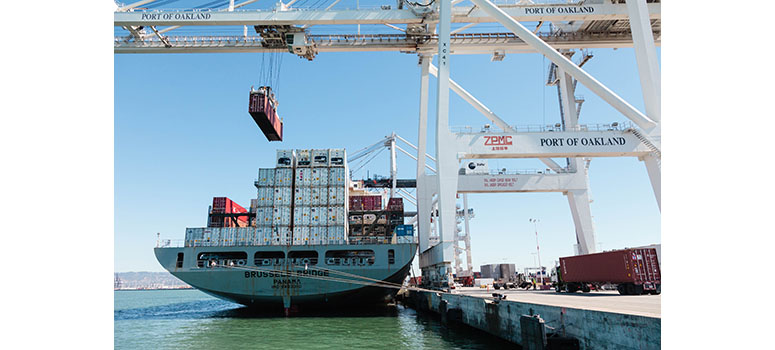So far, a potential U.S.-China trade war hasn't dampened cargo volume growth at California's third largest ocean cargo gateway. In fact, the Port of Oakland is on track for its third straight year of record container volume in 2018.

The Port of Oakland is on track for its third straight year of record container volume in 2018. However, experts say that this could be caused by shippers accelerating orders to beat the new tariffs on Chinese imports. Photo courtesy of Port of Oakland
BY PATRICK BURNSON
Published: December, 2018
So far, a potential U.S.-China trade war hasn’t dampened cargo volume growth at California’s third largest ocean cargo gateway. In fact, the Port of Oakland is on track for its third straight year of record container volume in 2018. But for Bay Area logistics managers, the one looming question is, “Can it last?”
When Oakland convened its quarterly meeting of its “efficiency task force” last month, the jury certainly appeared to be out on this issue. Since its creation three years ago, the task force has included stakeholders drawn from a variety of trade sectors, including longshore and labor representatives, freight intermediaries and executives from the nation’s leading ocean cargo shippers.
In their recent evaluation of trade dynamics, the majority of these members maintain that cargo volume is spiking right now, but could drop by January. Task force members noted three trends: First, warehouses are filling up as U.S. retailers import merchandise from Asia. Second, shipping lines have added more than 30 extra voyages to regularly scheduled transpacific services to transport larger container volumes. Third, ports up and down the West Coast have reported unprecedented cargo volume growth since mid-summer.
Potential reasons for the cargo spike vary. It could be the result of a continued strong U.S. economy, as this was also the peak season when importers ordered heavily for holiday merchandising.
However, another explanation for the spike was top of mind for Oakland’s task force—frontloading. Experts said that shippers have accelerated orders to beat the imposition of new tariffs on Chinese imports.
“Imports are a good story, but the reason for the growth is still something of a mystery,” said Port of Oakland Maritime Director John Driscoll. “We suspect frontloading is part of the answer.” More than one official predicted declining January imports as new U.S.-imposed tariffs take effect. Others said import volume should keep climbing until then.
Oakland said its import volume is up 2.7 percent over 2017, which was a record year for containerized cargo at the port. Furthermore, imports from China have increased five percent this year, despite the tariff skirmish.
Oakland exports to China have declined 33 percent in 2018, with spokespeople attributing that trend to be consequence of tough new Chinese restrictions on wastepaper shipments, an Oakland export staple.
“As Oakland’s China exports decline, other Asian nations are picking up the slack,” said Mike Zampa, the port’s communications director. “Export shipments to Vietnam soared 96 percent in September, for example, and exports to Taiwan increased 37 percent.”
But smaller U.S. West Coast ports may have a tougher time of mitigating the impact of a prolonged trade war with China, say analysts from Beacon Economics, a prominent California think tank.
Jock O’Connell, Beacon Economics’ international trade advisor in Sacramento, noted that the Port of Stockton has reported job and revenue losses as the result of a slowdown in shipments of 150-meter segments of rail that the Union Pacific Railroad imports from Japan.
“Manufactured by the Sumitomo Corporation, the rail segments are shipped to Stockton aboard a specially designed vessel, the Pacific Spike,” he said. “The segments are then welded at the Port of Stockton into 450-meter segments that Union Pacific uses in upgrading trackage along its 32,000-mile network in 23 states.”
Nonprofit Mission Supports Seafarers in the Bay Area
In this season of giving, Bay Crossings readers are encouraged to consider contributing to a great nonprofit resource that cares for the men and women serving on ocean cargo vessels and with dockside operations.
Founded in San Francisco in 1946 as the Scandinavian Seamen’s Mission, the Seafarers Ministry of the Golden Gate (SMGG) responds to the spiritual, emotional and physical needs of seafarers and port workers in San Francisco Bay.
The mission is located at the Port of Oakland, where its chaplain visits seafarers on ship, provides communication resources such as internet and phone cards, and welcomes visitors to the International Maritime Center (IMC). The IMC is a place of sanctuary for seafarers away from the ship where they can call home, play games and visit with volunteers. Transportation to local shopping is another service provided by SMGG.
Finally, it is worth noting that seafarers of all religious denominations have recently rated the mission as one of the top three such centers in the world. For more information, see www.smgg.org.
Patrick Burnson is the executive editor of Logistics Management. www.logisticsmgmt.com

